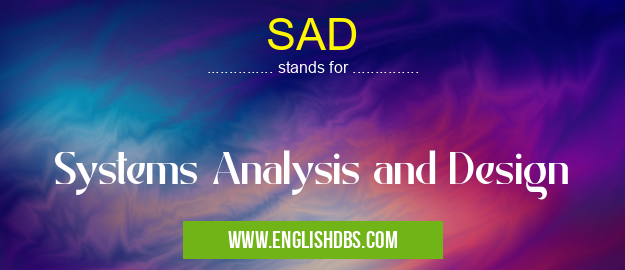What does SAD mean in ASSEMBLY
Systems Analysis and Design (SAD) is a process of exploring, understanding, and defining the requirements of a system, analyzing and designing the proposed business solution to meet those requirements, building or purchasing component subsystems to implement the design, validating and testing each component subsystem individually, integrating all components into one cohesive whole, and installing the system.

SAD meaning in Assembly in Computing
SAD mostly used in an acronym Assembly in Category Computing that means Systems Analysis and Design
Shorthand: SAD,
Full Form: Systems Analysis and Design
For more information of "Systems Analysis and Design", see the section below.
Essential Questions and Answers on Systems Analysis and Design in "COMPUTING»ASSEMBLY"
What is Systems Analysis and Design?
Systems Analysis and Design (SAD) is a process of exploring, understanding, and defining the requirements of a system, analyzing and designing the proposed business solution to meet those requirements, building or purchasing component subsystems to implement the design, validating and testing each component subsystem individually, integrating all components into one cohesive whole, and installing the system.
What are the key steps in SAD?
The key steps in SAD include exploring user needs and requirements; developing conceptual models; creating data models; designing user interface prototypes; constructing actual systems modules; implementing systems modules with code development (or purchase); testing systems for functionality; integration of subsystems into an overall system; installation of the complete system; training users on its use; documenting standards for maintenance.
Is SAD focused only on software applications?
No. Although software applications are often associated with SAD because they are such an integral part of it, there are other aspects as well. For example, SAD considers hardware dependencies that may be needed to support application modules or systems being implemented as well as network infrastructures that may require changes prior to successful implementation.
Who typically performs Systems Analysis & Design?
Typically a team composed of subject matter experts (SMEs), IT management personnel or consultants would be utilized for this purpose. SMEs provide guidance about existing processes that need improving or new processes that need creating while IT management personnel provide insight into how best to execute these tasks from an IT standpoint. The task may also involve outside consultants who have expertise in specific areas related to the project at hand.
How long does it take?
It depends on several factors - complexity of problem being solved by applying SAD principles need to be considered when estimating total time required for completion. On average most projects require around 4-5 months if all necessary resources are available timely.
Final Words:
Systems Analysis and Design is an important process for businesses wanting to ensure their IT needs are met efficiently, effectively and successfully within reasonable timelines. Through this process companies can discover user requirements from both technical as well as non-technical perspectives which can help them develop more efficient workflows across their operations resulting in improved productivity among users involved with their respective tasks throughout the organization.
SAD also stands for: |
|
| All stands for SAD |
